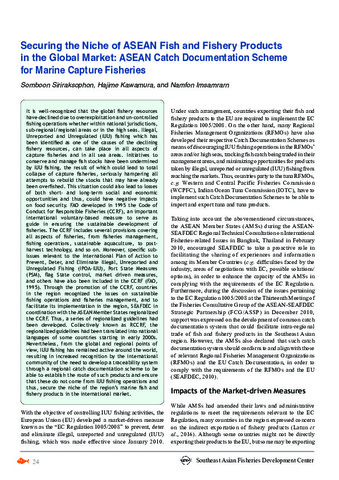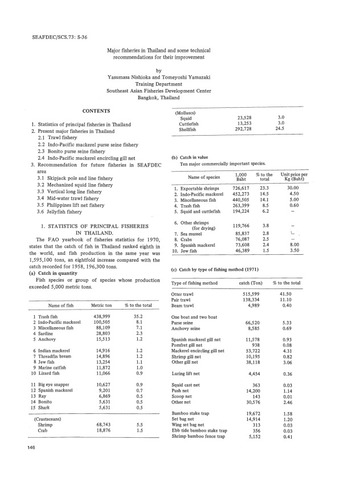| dc.description.abstract | It is well-recognized that the global fishery resources have declined due to overexploitation and un-controlled fishing operations whether within national jurisdictions, sub-regional/regional areas or in the high seas. Illegal, Unreported and Unregulated (IUU) fishing which has been identified as one of the causes of the declining fishery resources, can take place in all aspects of capture fisheries and in all sea areas. Initiatives to conserve and manage fish stocks have been undermined by IUU fishing, the result of which could lead to total collapse of capture fisheries, seriously hampering all attempts to rebuild the stocks that may have already been overfished. This situation could also lead to losses of both short- and long-term social and economic opportunities and thus, could have negative impacts on food security. FAO developed in 1995 the Code of Conduct for Responsible Fisheries (CCRF), an important international voluntary-based measure to serve as guide in ensuring the sustainable development of fisheries. The CCRF includes several provisions covering all aspects of fisheries, from fisheries management, fishing operations, sustainable aquaculture, to postharvest technology, and so on. Moreover, specific sub issues relevant to the International Plan of Action to Prevent, Deter, and Eliminate Illegal, Unreported and Unregulated Fishing (IPOA-IUU), Port State Measures (PSM), flag State control, market driven measures, and others have also been included in the CCRF (FAO, 1995). Through the promotion of the CCRF, countries in the region recognized the issues on sustainable fishing operations and fisheries management, and to facilitate its implementation in the region, SEAFDEC in coordination with the ASEAN Member States regionalized the CCRF. Thus, a series of regionalized guidelines had been developed. Collectively known as RCCRF, the regionalized guidelines had been translated into national languages of some countries starting in early 2000s. Nevertheless, from the global and regional points of view, IUU fishing has remained active around the world, resulting in increased recognition by the international community of the need to develop a traceability system through a regional catch documentation scheme to be able to establish the route of such products and ensure that these do not come from IUU fishing operations and thus, secure the niche of the region's marine fish and fishery products in the international market. | en |




